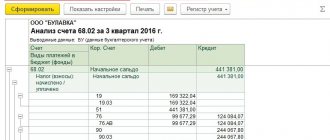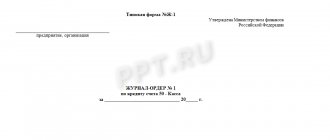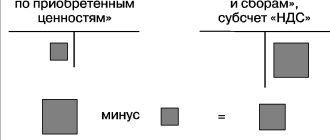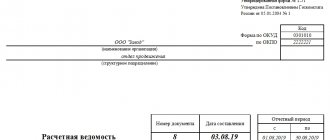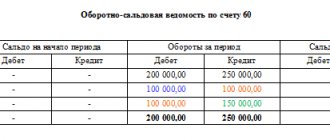Inventories: what to include, how to take into account
All company assets that have a useful life of less than 12 months should be classified as inventories.
For example, raw materials, materials, semi-finished products, components, packaging, fuel, inventory and other similar assets. To systematize and generalize information about the cost and quantitative indicators of inventories, account 10 “Materials” is used (Order of the Ministry of Finance No. 94n). These requirements apply to non-profit organizations, commerce and small businesses. State employees use accounting accounts in accordance with Instruction No. 157n. Material reserves in a budgetary institution are reflected in the accounting account of the same name 0 105 00 000.
It is permissible to take into account values in two ways: at actual cost (clause 62 of Order No. 119n) or at accounting prices using 15 and 16 accounting accounts (clause 80 of Order No. 119n dated December 28, 2001).
The company independently chooses the accounting method suitable for the specifics of its activities. This choice must be justified in the accounting policies of the institution. Also in the accounting policy, indicate the forms of primary and accounting documentation that will be used to reflect operations on the movement of money.
The method for writing off materials from the 10th account should also be written down in the accounting policy. Three methods are allowed:
- Based on the average cost of inventories.
- Based on actual unit cost.
- FIFO method.
The cost of inventories may include not only the actual price paid, but also other costs. For example, consulting services, non-refundable customs and tax duties, non-refundable VAT, delivery costs, and other costs associated with the receipt of goods.
Write off
Materials are subject to disposal in cases where they are transferred to production, for management purposes, upon sale, damage, or shortage. You can write off materials by evaluating them in one of three ways:
- at the cost of each unit (clauses 16, 17 PBU 5/01). This method is used mainly with a unique price for each unit of purchased inventories and involves accounting for each unit. The disposal of each unit in this case is written off at its acquisition price;
- at average cost (clauses 16, 18 PBU 5/01). This method assumes the presence of inventory groups in analytical accounting. It is advisable to prescribe the principle of their distribution into groups in the accounting policy. With this write-off method, the unit cost is calculated as the ratio of the amount of the debit balance of the account. 10 at the beginning of the month and the debit turnover on this account for this month to an amount equal to the amount of materials in the account. 10 at the beginning of the month and the number of materials received this month. To calculate the amount of disposal of all materials of a group, you need to multiply the average cost of inventories of this group by the number of retired materials of this group;
- at the cost of the first in time of acquisition (FIFO) (clauses 16, 19 PBU 5/01). Accounting by groups is assumed, as in the previous version. Write-off occurs at the price of early purchases in each group: the first write-off is at the price of inventories listed at the beginning of the month. At this price, the quantity that is accounted for at the beginning of the month is written off. If such a number of inventories are written off, we begin to write off at the price of those inventories that were purchased second from the beginning of the month, etc.
The chosen method is fixed in the accounting policy.
The listed methods for determining the value of inventory for write-off are not used by retail trade organizations (they write them off at the sales price) and those who keep simplified accounting (they can write them off at the purchase price).
Opening sub-accounts for account 10
Order of the Ministry of Finance No. 94n determines that in order to organize complete, reliable and detailed accounting of the company’s material assets, the opening of additional sub-accounts is provided. This approach allows you to group all the organization’s inventory items by type.
| Number | Name | Content |
| 10.1 | Raw materials | Reflect material assets that are used to carry out the main activity |
| 10.2 | Semi-finished products | Components, components, structures and parts that are used in the main and auxiliary production cycles and processes |
| 10.3 | Fuel | Fuel and lubricants, gasoline, diesel fuel, gas, motor oils, etc. |
| 10.4 | Tara | Materials used as containers and (or) packaging |
| 10.5 | Spare parts | Spare parts used for repair and maintenance |
| 10.6 | Other inventories | Values not included in other groups |
| 10.7 | Materials for external processing | MPZ intended for external processing |
| 10.8 | Construction materials | To reflect information about the availability and movement of building materials from developers |
| 10.9 | Household equipment | Materials and equipment, accessories and equipment used to perform general economic work |
Please note that opening all accounts is not necessary. The organization independently decides which subaccounts will be used in accounting. So, for example, account 10.10 - what applies to a particular institution must be defined in the accounting policy. Typically, special equipment (special equipment) is included in this subaccount.
Fixed Assets (Fixed Assets)
It is necessary to check whether all objects have been accepted for accounting. And when disposing of fixed assets, the documents must indicate the reasons and grounds for the disposal of a fixed asset that could still work. It is important to take into account the consequences of further disposal - liquidation, since the residual value of liquidated fixed assets is taken into account as expenses.
For example, the act in form No. OS-4 must state: before liquidation, the OS is disassembled, and the company plans to use its parts and components.
Features of inventory accounting
Account 10 belongs to the active group of accounts. Consequently, debit 10 of the accounting account (for dummies) reflects the receipt (increase) of material assets, and credit turnover reflects the disposal of assets from the corresponding accounting accounts. The ending balance can only be in debit. A credit balance indicates that there is an error in recording accounting transactions.
Inventory accounting needs to be detailed. To do this, provide for maintaining detailed analytical records in the context of items, batches, storage locations, materially responsible persons and departments.
The actual presence of MC must be periodically monitored. Accountants are required to conduct inventory checks to identify deviations from accounting indicators and actual availability. The reconciliation procedure and frequency should be established in the accounting policy.
Results
It is difficult to imagine a production organization that purchases a small amount of material assets. The process of forming OSV itself is simple. The main problem is the variety of items, warehouses, financially responsible persons and a large volume of primary documents.
Several participants may be involved in the chains of acquisition and write-off of materials: a supplier, a storekeeper, workers or craftsmen who receive materials for production, and sales employees. The primary document can get lost at any stage of inventory movement and not reach the accountant. So, first of all, the accountant is interested in creating a document flow that will allow receiving primary data in a timely manner and in full.
Currently, SALTs are generated automatically, based on primary documents entered into accounting programs.
However, do not forget that you need to oblige the storekeeper (or other materially responsible person) to keep warehouse records in quantitative terms (in cards or special journals). Then, discrepancies identified during reconciliation of accounting and warehouse data will help you find documents that did not reach the accountant or storekeeper. You can find more complete information on the topic in ConsultantPlus. Free trial access to the system for 2 days.
Revolving balance sheet: accounting 10
When maintaining automated accounting, it is recommended to systematically generate interim reporting in order to control the movement of material assets. One of such reports is the balance sheet for account 10. The accounting document contains information on the availability of MH balances at the beginning and end of the reporting period, as well as on the movement (receipt and disposal) of materials during the reporting period.
SALT is a separate accounting register that reflects information on the availability of material assets at the beginning of the reporting period, information on the movement of inventories (receipts and disposals), and also indicates the amount of raw materials remaining at the disposal of the company at the end of the reporting period.
Principles for drawing up a balance sheet:
- The negotiable SV must necessarily disclose accounting information:
- balance at the beginning of the reporting period - quantity and value;
- cost and quantitative expression of Ministry of Health revenues;
- value and quantity of disposed assets (write-off);
- final balance on account 10.
- If the company has structural divisions, it is necessary to organize additional analytics. For example, create turnover sheets separately for each warehouse space. Indicators of the consolidated balance sheet reflect data for the organization as a whole and are used for reporting.
- Automation of accounting and compilation of WWS does not exempt the entity from the mandatory maintenance of warehouse cards for materials accounting. The card must be issued for one calendar year. Moreover, the document is drawn up for only one item number. It is not allowed to combine MH accounting in cards.
- Primary documents confirming the movement of raw materials must be drawn up on paper. Facts of changes in the indicators of inventories must be certified by the “live” signatures of responsible employees. Keeping records electronically requires certification of documentation with electronic signatures of the chief accountant or head of the company.
IMPORTANT!
The statement reflects not only the value expression (rub.), but also quantitative accounting indicators (kg, m, pcs., units, etc.).
What is required to create a statement. Sample OSV 10
Movements in the debit of account 10 are formed in the turnover using primary documents: TORG-12 invoices, receipt orders. In some cases, invoices.
Receipts from the founder are formalized on the basis of an appraisal report, an invoice, a decision or minutes of a meeting of the founders.
Credit turnover is the result of writing off inventories for production and business purposes. The main document for writing off the requirement is the invoice. Based on the loan, the cost of production is formed at the end of the month.
The organization must appoint an employee who is responsible to management for all movements of inventories. For each type of raw material, cards are created that indicate information: name, grade, color, packaging, storage location. All internal documents are certified by the warehouse employee with a personal signature.
At the end of the month, a storekeeper or other financially responsible employee calculates movements and balances in quantitative terms.
Everything is recorded in a file cabinet or inventory journal. Table 2. Receipt at warehouse
| Item no. | Name | quantity | Unit price excluding VAT in rubles |
| 1 | Corrugated fittings 0.5 mm | 400 kg | 150 |
| 2 | Equal angle corner 50x50 | 150 kg | 220 |
| 3 | Zinc profile 1.5 m | 220 kg | 177 |
Table 3. Written off from warehouse
| Item no. | Name | quantity | Unit price excluding VAT in rubles |
| 1 | Corrugated fittings 0.5 mm | 300 kg | 150 |
| 2 | Equal angle corner 50x50 | 100 kg | 220 |
| 3 | Zinc profile 1.5 m | 200 kg | 177 |
In the accounting department for account 10, on the basis of internal warehouse documents, the turnover sheet is filled out.
Table 4. Example
| Name | Initial balance | Debit turnover | Loan turnover | Final balance | ||||
| Qty | Cost in rubles | Qty | Cost in rubles | Qty | Cost in rubles | Qty | Cost in rubles | |
| Corrugated fittings 0.5 mm | 70 | 10 500 | 400 | 60 000 | 300 | 45 000 | 170 | 25 500 |
| Equal angle corner 50x50 | 10 | 2 200 | 150 | 33 000 | 100 | 22 000 | 60 | 13 200 |
| Zinc profile 1.5 m | 80 | 14 160 | 220 | 38 940 | 200 | 35 400 | 100 | 17 700 |
| Total | 160 | 26 860 | 770 | 131 940 | 600 | 102 400 | 330 | 56 400 |
Example of filling out the OCB
Data from NPO "DOBRO" for March 2021. For inventories used by the organization to conduct its main activity:
- purchased MH for the amount of 200,000 rubles;
- released into production in the amount of 220,000 rubles;
- spoiled in the amount of 3000 rubles.
Balance sheet for accounting account 10 for March 2021:
Accounting ledger example
SALT is compiled at the end of each month based on data for each synthetic account. All of them are reflected in the document. A separate line is used to record each account.
It states:
- opening balance;
- loan turnover;
- debit turnover;
- ending balance.
In practice, movements of funds in a particular month do not always occur. However, the statement in this situation must still be filled out. Instead of the usual set of data, it reflects only the opening and closing balances.
The document must be filled out without errors. The accountant who prepared the statement must check it.
When carrying out manipulation, you must be guided by the following rules:
- the result of calculating initial debit balances must coincide with the result of determining similar credit balances;
- the result of debit turnover must be equal to credit;
- the result of determining the final balances must coincide with the final credit balance.
The preparation of the paper is based on the use of dual notation. Manipulation allows you to control the correctness of recording business transactions. If there is no equality, an error has been made. The calculations must be done again.
Accounting and control
A company can organize accounting in two ways.
Option #1.
First, write out a paper document. For example, a request for an invoice for the movement of goods and materials. Then the responsible persons carry out the transfer and complete the execution of the primary document. And only then are they transferred to the accounting department. The responsible accountant enters the data into the program.
Option number 2.
An accountant or warehouse worker enters information about the movement of inventories into a specialized accounting program. Then it prints out the document and submits it to the responsible persons for signature.
Regardless of the chosen accounting option, do not forget about errors. However, accounting indicators must always correspond to actual data. Therefore, it is necessary to organize systematic checks. It is recommended to carry out monthly reconciliations of SALT data with actual warehouse accounting indicators.
Instruct the responsible accountant to carry out counter reconciliations with financially responsible persons. These can be not only MOLs for warehouses, but also for all departments where inventories are stored. Correct any errors found in accounting in accordance with current standards. It is advisable to carry out control activities before the closing of the reporting period.
We capitalize the receipt
Before recording funds received into the account. 10, you need to recalculate everything and compare it with the quantity and name indicated in the seller’s document, usually TORG-12 or TTN, and inspect for defects.
If the inspection reveals no problems, everything is in place and in excellent condition, they are transferred for reporting to the storekeeper without registration at the warehouse. Documentary posting is executed by an invoice in the unified form M-4 or in free form with the mandatory details established by law 402-FZ. Another option is to put a “posted” stamp on the seller’s document with the name of your company, date of posting, full name. and the position of the responsible person and his signature.
If, however, the check shows that not everything is as expected, you need to draw up a report on the defects of the goods in terms of quantity or quality. In this case, the actual quantity of received materials with quality that satisfies you is subject to capitalization.
Synthetic and analytical accounting
Accounts that are intended for a generalized reflection of economic assets and their sources are considered synthetic. This type is used to account for company funds in a single monetary value.
Written recording of a completed transaction is called synthetic accounting. The category includes all accounts that belong to the assets and liabilities of the balance sheet, and are also reflected in the chart of accounts.
Synthetic accounting is used:
- to fill out reports,
- to fill the balance,
- analysis of the financial and economic activities of the company.
To control the safety of valuables, you need to know not only their total value, but also other data necessary for identification. If a company has accumulated debt, along with finding out its total volume, it is necessary to determine the reason for its occurrence.
To perform manipulations of this kind, analytical accounts are used. They allow you to clarify and control the data of synthetic accounts.
Analytical accounts allow you to keep records in both physical and monetary terms. They open in addition to synthetic ones. Recording transactions with category accounts is called analytical accounting. Its implementation is necessary to control and ensure the safety of inventory items.

